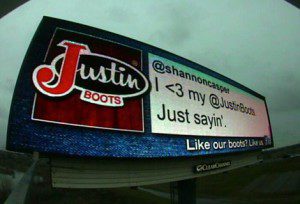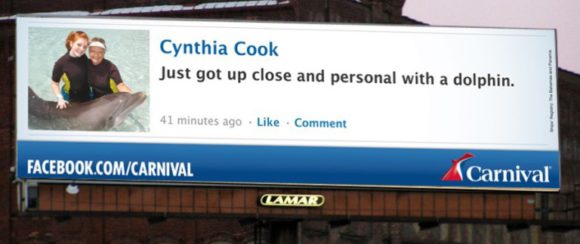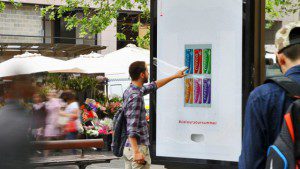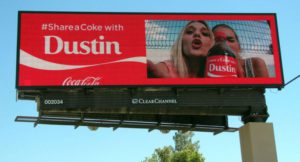Last week we discussed the topic, Inbound vs. Outbound Marketing. We ended that discussion debating on which method your company should use. Should you use inbound, outbound, or maybe a combination of the two? Ultimately, we said it really depends on who your target market is, and which method would work best with them. However, if you have the resources available, you could choose to do both!
Companies don’t have to pick just one way or the other when they combine the two methods. Instead, they can choose multiple ways of reaching their customers without having to limit themselves. In fact, they can even come up with an advertising method that intertwines both inbound and outbound marketing. Let’s explore this option further, and we’ll talk about a couple of examples where these two methods are effectively being combined.
The Mixture
In my previous blog, I briefly mentioned digital billboard advertising as an example of both inbound and outbound marketing. I’d like for us to go into more depth about it, but first, let’s watch the video below.
Lamar Advertising is a company that has done a brilliant job of combining these two marketing strategies. To reach a bigger audience, this company, along with a few others, have taken the traditional, outbound marketing method of billboards and added an inbound marketing twist. Being digital, these billboards can update constantly based on consumer data, interactions, and more.
As you saw in the video, Lamar Digital Billboards can display:
- Trending items
- Live game scores
- User-generated content
- Social media posts
- Countdowns
- Relevant information based on the day and time
- Ads relating to the current weather
 Incorporating inbound marketing into billboards has been really successful for companies. It has increased their customer traffic simply because of the digital attractive and engaging displays.
Incorporating inbound marketing into billboards has been really successful for companies. It has increased their customer traffic simply because of the digital attractive and engaging displays.
According to a recent study by the Outdoor Advertising Association of America, 75% of people who participated said that during the past month, they noticed digital billboards, and 55% of those in the study remembered the message of the billboard.
So, why is that? In my opinion, I believe the statistics are so high simply because these billboards incorporated inbound marketing. People enjoy when companies engage with them, and that is exactly what these billboards are doing. In fact, according to the same study stated earlier, 22% of people followed advertisements after they saw it being presented on a digital billboard.
Here are a few examples of companies using digital billboards to encourage consumer involvement:
- Coca-Cola’s Tweet Your Name for Fun Facts
- March Madness Scores and Live Tweets from Fans
- Forever 21 Augmented Reality Billboard – Virtual Photo of Shoppers
 It gets people’s attention when they see something unique and interesting that engages with real consumers.
It gets people’s attention when they see something unique and interesting that engages with real consumers.
When the billboards update with live social media feed, it makes the advertisement more authentic and shows viewers that the company wants to build relationships with their consumers. People tend to rely on word of mouth when making decisions, so when they see real comments from people like themselves, it provides more incentive for them to try the product or service as well.
Billboards have come a long way, but so have other forms of advertisement. So, let’s talk about a couple more great examples that mix the two methods, inbound and outbound, into one. For example, advertising panels, such as bus shelters and free-standing information panels. Similar to the billboards we just discussed, both of these examples were originally considered outbound marketing, but now they are incorporating inbound marketing by becoming digital.
Check out this video to see what I mean:
In the Batman vs. Superman bus shelter video, you can see how the company took the outbound marketing method to a whole new level by meshing it with inbound marketing. Instead of having just paper advertisements in the panels, they added life-size figures on top of the shelter and added a digital feature for people to interact with.
In this example, the digital panel gave people the option to take a picture of themselves looking like Batman or Superman. Once the picture was taken, and they entered their email address, their picture was automatically sent with the option of posting it on their social media accounts. This is such a great idea because it gives people an incentive to post about their experience on social media. By including all of these attractive aspects, people are easily able to remember the message that the company is advertising.
In the following video, you will see some awesome, creative international campaigns by JCDecaux:
As you saw in the video, a lot of the advertising campaigns shown were digital, and all of the campaigns influenced people to engage with them. By doing this, they were able to increase brand awareness for the companies that are being advertised. People were able to play games, virtually try on products, and some were given samples for interacting with the advertisement.
With a such a unique display, people naturally took pictures with their free samples or the panel itself. Some of these advertisements even encouraged people to post on social media in order to get a free sample when they go to the advertised store. All at the same time, people were remembering the brand and the intended message that the company was trying to send to their customers.
This company, JCDecaux, easily combined outbound and inbound marketing through their advertising. With the use of touchscreen displays, they were able to easily connect people to their company’s brand by encouraging the use of mobile devices and posting on social media.
The Impact
 These companies created an experience for people and encouraged them to get involved with the advertisement, and by doing so, they made their brand one to remember.
These companies created an experience for people and encouraged them to get involved with the advertisement, and by doing so, they made their brand one to remember.
Since they decided to mix inbound and outbound marketing, these companies were able to reach a bigger audience and impact current and potential customers. In return, it not only helped increase sales but also brand awareness. Traditional advertising often times isn’t as effective as inbound marketing. So, in my opinion, combining the two makes the perfect mix.
Overall, it is important to focus on how to build a relationship with your consumers, connect them with your brand, and create an experience for them to share with all of their friends and family. If you do this, I’m sure you will create a brand that will be loved and remembered.

Do you have any innovative ideas for combining the two, inbound and outbound? Let us know! We would certainly love to hear them!

Leave a Reply
You must be logged in to post a comment.